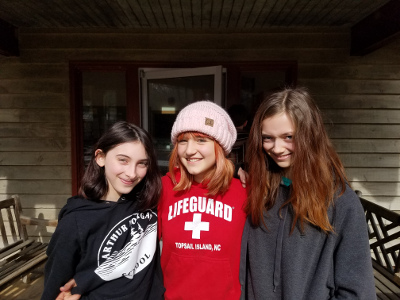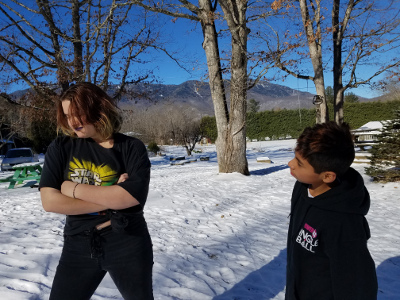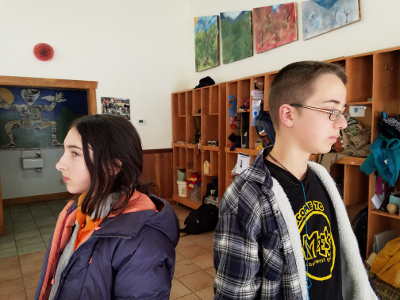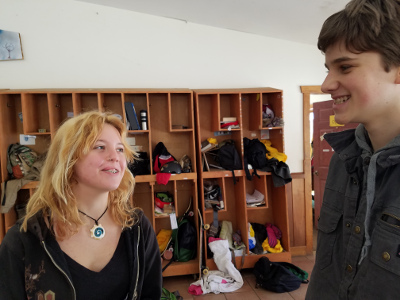Building Kindness in the Classroom

School communities often struggle. Students become tired and stressed. They may lash out or act insensitively with their peers. As tensions increase and students respond with defensiveness or retribution, the ideals which tether a school community can start to unravel. As a result, any kindness that a teacher may be trying to build in their classroom risks fading away.
Stormy Times
This stress is normal of course. All groups need to occasionally go through rough patches. It helps them determine their strengths and blind spots. Bruce Tuckman categorized the stages of group development in 1965 with his forming, storming, norming, performing model. Tuckman said it is essential for groups to face difficulties and then work through them in order to be successful.
 At Arthur Morgan School right now, our middle schoolers have been storming. Throughout the fall semester and into the December unit, staff and students have noted a tension building in their community. “People are being disrespectful. They are talking over one another. They don’t listen. It’s bad!” Scout, an eighth grader described it. The culture of kindness and acceptance, which so many like about AMS, has been fading. Something needed to be done.
At Arthur Morgan School right now, our middle schoolers have been storming. Throughout the fall semester and into the December unit, staff and students have noted a tension building in their community. “People are being disrespectful. They are talking over one another. They don’t listen. It’s bad!” Scout, an eighth grader described it. The culture of kindness and acceptance, which so many like about AMS, has been fading. Something needed to be done.
Pushing Kindness vs Building It
For many schools finding a way to bring kindness into the classrooms is a very challenging task. Top down messages from administrators or teachers can have little effect. School assemblies feel contrived or staged. When the message to be kinder to one another comes from above or some specialized event, it is difficult to achieve the student buy-in necessary for these efforts to succeed. Middle schoolers know when they are being cajoled and almost always resist it. They want to determine their own morals, no longer satisfied with taking adults’ words for it.
Every Wednesday, AMS holds All School Meeting. During this time students can participate in the running of the school. They might make decisions about the school schedule or how chores are run. They may plan an event or change a school rule. Other times, the topics in All School Meeting are less concrete like deciding about the type of community they’re trying to build.
Learn more about how AMS’s student governance!
This week, the students looked at their culture and what it meant to be at AMS. The conversation could have been a difficult one. In another setting, students may have felt shamed for their recent behavior or lectured each other about how they should treat one another better. In this All School Meeting, however, something very different took place.
Making Students Part of the Conversation
 The students were asked what they loved and appreciated about AMS. Together they generated a long list. Some of the items were simple things like less time in the classroom and prepared spaces to play and express themselves. However, other students mentioned more complex concepts like the freedom to be their authentic selves, the encouragement to build relationships across personal differences, and a lack of hierarchy both in the middle school population and between staff and students. Trust and respect were reoccurring themes. As one student put it, “trust is the greatest gift you can give someone.”
The students were asked what they loved and appreciated about AMS. Together they generated a long list. Some of the items were simple things like less time in the classroom and prepared spaces to play and express themselves. However, other students mentioned more complex concepts like the freedom to be their authentic selves, the encouragement to build relationships across personal differences, and a lack of hierarchy both in the middle school population and between staff and students. Trust and respect were reoccurring themes. As one student put it, “trust is the greatest gift you can give someone.”
The students were then asked to reflect on the list and think about how they were (or were not) contributing to this vision. The result was magical. The ninth graders set the tone for an open and vulnerable conversation. In turn, each spoke up and took responsibility for the ways they could be doing better. They admitted that they could do a better job of seeking understanding toward one another, that they would sometimes lash out instead of finding a non-violent method of resolving their conflict. They talked about shutting down and avoiding conflict only for it to come out through gossip or defensiveness.
Many of the other students followed suit and soon the conversation became one in which everyone was acknowledging what they could do to make AMS the school they wanted it to be. Taking personal responsibility for the ways the community was struggling was an uplifting process. Instead of feeling shame, the students felt compassion toward one another. They empowered themselves to be the creators and stewards of their school community. If they wanted a culture of kindness and acceptance, it was up to them to make it and then safe guard it.
 Storming to Performing
Storming to Performing
Every community goes through its struggling point. They need to storm in order to norm and finally perform in the way they were meant to. The middle schoolers of AMS just took a giant step toward that goal, and they did it through their own self governance. If the all school meeting had been a special event, it might have been conceived as a disciplinary tactic in disguise. For the AMS student though, it was just another Wednesday and creating kindness in the community was just a normal part of running their school.
-By Nicholas Maldonado
